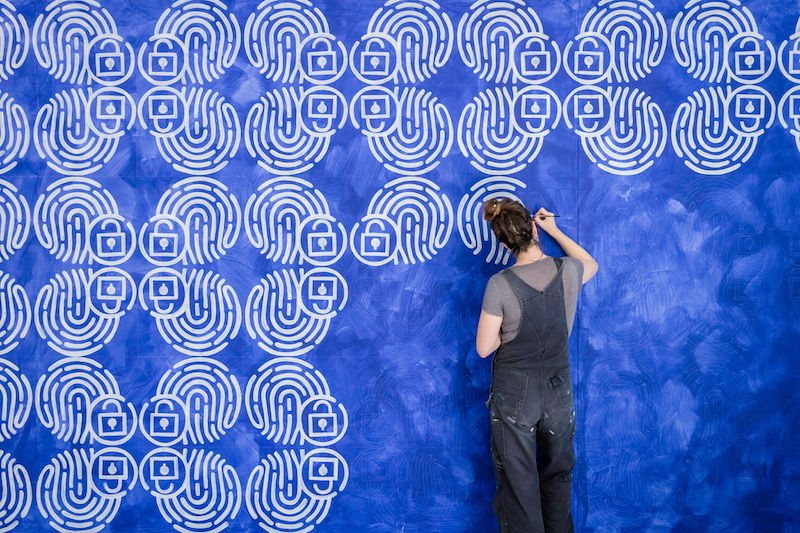“There is no alternative”, Margaret Thatcher asserted, over and again, as a defence of neoliberalism. At The Showroom, almost three decades after the end of Thatcher’s time in office, Navine G. Khan-Dossos deploys the phrase as a critique of contemporary counter-terrorism policies in England, Wales and Scotland, suggesting that they too rely on a comparable failure of imagination and a radical refusal to contemplate dissent. Her exhibition takes for its starting point the artist’s research into Prevent, a government programme that obliges police officers, teachers, doctors, mental health workers and nursery staff to report any signs of religious or political ‘extremism’ in those under their care.
The show comprises two brightly coloured abstract murals and nine moveable panels – the latter of which the artist is ‘live painting’ during the exhibition’s opening hours and will continually rehang in different places over the murals – that cover the gallery walls. The centre of the space is occupied by a long table, divided into discrete cubicles by fabric desk-screens, stacked with folders, pamphlets and documents pertaining to a programme that has attracted criticism from rights groups for its perceived bias against Muslim communities and for its surveillance of children (memorably a four-year-old boy referred to a ‘deradicalisation’ programme after nursery staff mistook his drawing of a cucumber for a ‘cooker bomb’).
This small library includes Preventing Prevent (2017) – a handbook put together by the National Union of Students – a survey by the Open Society Justice Initiative on human-rights violations, official documents secured through the Freedom of Information Act and government guidelines. Khan-Dossos is also running a series of workshops, open to all and free to attend, that sift through the paperwork and consider (in direct opposition to the exhibition’s title) alternatives to Prevent. Leafing through these documents reveals another of the programme’s most striking implications, the ‘pre-criminality’ written into the logic of legislation that aims to identify culprits in advance of their having committed any offence: a thoughtcrime, to use the Orwellian term.
The UK-born and Athens-based Khan-Dossos (whose name is an anagram of the one she was given) articulates her research though a form of abstract painting. Aniconism (literally ‘no image’) is a way of conveying information through geometric rather than figurative representation and, drawing on this technique, Khan-Dossos repeats a single shape discovered in the course of her investigations to form a complex lattice. The appropriation of this aniconic technique is risky: a tradition associated with Islamic religious painting, and specifically its proscription of figurative representation, is applied to study the information hidden within a range of contentious images. She has in previous exhibitions examined the ISIS flag: a black square which acts as a watermark in the organisation’s so-called ‘martyrdom videos’ formed the basis for her series The Black Standard (2016). Another series (Infoesque, 2017) looked at the graphic design of ISIS’s propaganda magazine Rumiyah, a PDF aimed at foreign recruits. It leads us to consider whether the production of these works by a white British artist constitutes a sign of ‘extremist’ tendencies, and if not, why not? Her physical presence in the space for large parts of the show – working in plain sight on the work – foregrounds the question.
On this occasion, Khan-Dossos has turned her attention to the graphic designs of the nationwide Prevent strategy. The absence of a single official logo – the programme outsources its training schemes to third-party providers – led to a proliferation of different designs, and so Khan-Dossos has gathered a cache of thumbnails from the websites and Twitter feeds of the police forces, schools and hospitals legally obliged to participate in the scheme since the Counter-Terrorism and Security Act of 2015.
One such logo, produced by Hampshire Constabulary Graphics Department, forms the basis of the mural unfolding along a 10-metre wall: a lime-green shield that morphs into a pair of shaking hands at its tip. Khan-Dossos has repeated the shield in vertical and horizontal lines, alternating its orientation so that flat edges form hexagons while the tips carve out a sharp diamond in the negative space. From the intersecting lines of these repeated forms a net emerges that covers the entire wall, transforming the apparently harmless symbolism of the logo into an image of nationwide surveillance. A second mural, rendered in blue along a nine-metre-long wall opposite, enlarges and repeats a pictogram by London’s Metropolitan Police – a biometric fingerprint lifted from Apple Touch ID overlaid with a circular open padlock – to create a pattern like whirled butterflies caught in a net, although the open padlock stubbornly resists abstraction.
Khan-Dossos’s strategy turns the intended symbolism on its head: logos originally intended to communicate personal security are abstracted to resemble menacing networks. In January, the Home Office announced that Prevent would be independently reviewed this summer. By revealing the hidden power structures behind superficially friendly graphic design, the exhibition alerts its viewers to the logic of a programme in which care and control entwine. The exhibition invites us to look more closely at such legislation – and to imagine alternatives – and consider how organisations in a surveillance society monitor how we think in order to pre-empt and suppress dissent.
Navine G. Khan-Dossos’s There Is No Alternative is at The Showroom, London, through 27 July
